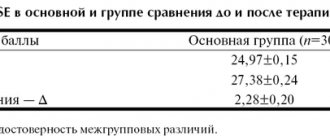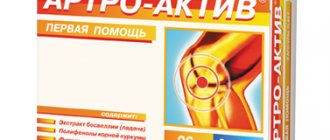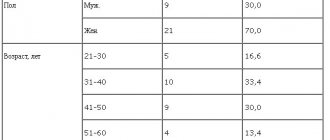Instructions for use SALOFALK® tablets
General properties of mesalazine
Suction
Mesalazine is absorbed most efficiently in the proximal intestine and least efficiently in the distal intestine.
Distribution
Plasma protein binding of mesalazine and N-Ac-5-ASA is 43% and 78%, respectively. Approximately 1% of an oral dose of mesalazine is excreted in breast milk, mainly as N-Ac-5-ASA.
Metabolism
Mesalazine undergoes first-pass metabolism to form inactive N-acetyl-5-aminosalicylic acid (N-Ac-5-ASA), both in the intestinal mucosa and in the liver. The pattern of acetylation is independent of the patient's acetylation phenotype. Part of mesalazine is also acetylated due to the action of bacterial microflora of the large intestine.
Removal
Mesalazine and its metabolite N-Ac-5-ASA are excreted in excrement (most of it), kidneys (the amount varies from 20% to 50% depending on the route of administration, dosage form and mechanism of release of the active substance) and bile (minor part) . It is excreted by the kidneys mainly in the form of N-Ac-5-ASA.
Specific features of the drug Salofalk® in the form of tablets 250 mg
Distribution
A combined pharmacoscintigraphic/pharmacokinetic study demonstrated that when taken with food (breakfast test), enteric film-coated tablets dissolve in approximately 3-4 hours in the ileum. The average time for evacuation of gastric contents was approximately 3 hours. After approximately 7 hours, the tablets reached the colon. In a subsequent study in volunteers, the evacuation time from the duodenum to the ileum was approximately 3 hours, with the highest concentration of 5-ASA in the intestinal lumen observed 7-8 hours after co-administration of the tablets with a test breakfast. Approximately 75% of the mesalazine dose reaches the large intestine unmetabolized.
Suction
The release of mesalazine from Salofalk® 250 mg enteric film-coated tablets begins after a lag phase of approximately 3-4 hours. The highest plasma concentration is achieved after approximately 5 hours (in the ileum) and with the administration of mesalazine at a dose of 500 mg 3 times/day (3×2 tablets. Salofalk® 250 mg) under the condition of steady-state equilibrium is 2.1±1.7 µg/ml for mesalazine and 2.8±1.7 µg/ml for its metabolite, N-A4-5-ACK.
Removal
During long-term treatment with Salofalk® 250 mg enteric film-coated tablets at a daily dose of 500 mg mesalazine 3 times a day (assuming steady state), the total rate of renal excretion of mesalazine and N-A4-5-ACK was approximately 55% (value obtained within 24 hours after the last dose). The proportion of unmetabolized mesalazine was approximately 5%. T1/2 is 0.7-2.4 hours (on average 1.4±0.6 hours) when using mesalazine at a dose of 500 mg 3 times a day.
Specific features of the drug Salofalk® in the form of tablets 500 mg
Distribution
A combined pharmacoscintigraphic/pharmacokinetic study demonstrated that when taken with food (breakfast test), enteric film-coated tablets dissolve in approximately 3-4 hours in the ileum. After approximately 4-5 hours, the tablets reach the colon. The total transit time in the large intestine is about 17 hours.
Suction
The release of mesalazine from Salofalk® 500 mg enteric film-coated tablets begins after a lag phase of approximately 3-4 hours. The highest plasma concentration is achieved after approximately 5 hours (in the ileum) and with the administration of mesalazine at a dose of 500 mg 3 times/day, subject to steady state equilibrium, is 3±1.6 µg/ml for mesalazine and 3.4±1.6 µg/ml for its metabolite, N-Ac-5-ASA.
Removal
The total rate of renal excretion of mesalazine and N-Ac-5-ASA within 24 hours with repeated doses (1 tablet 500 mg 3 times a day for 2 days; and 1 tablet on the third control day) was approximately 60% ( value obtained within 24 hours after the last dose). The proportion of unmetabolized mesalazine was approximately 10%.
Salofalk
Before starting treatment, during, and after treatment, a general blood and urine test is necessary.
Before starting treatment and during its implementation, it is necessary to determine parameters of the functional state of the liver (such as ALT or AST activity) and monitor urine tests (using immersion test strips). Monitoring is usually recommended 14 days after the start of treatment, then 2-3 more times with an interval of 4 weeks. If test results are normal, follow-up studies should be performed every 3 months. If additional symptoms occur, follow-up studies should be performed immediately.
Use with caution in patients with impaired liver function.
The use of Salofalk is not recommended for patients with severe renal impairment. If renal dysfunction develops during treatment, the nephrotoxic effect of mesalazine should be considered. During treatment, renal function should be monitored.
When prescribing Salofalk to patients with lung diseases, in particular bronchial asthma, it is necessary to exercise careful monitoring during treatment.
Patients with a history of indications of adverse reactions when prescribed drugs containing sulfasalazine are subject to careful monitoring during the initial period of treatment with Salofalk. If, during treatment with Salofalk, acute intolerance reactions occur, such as cramps, acute abdominal pain, fever, severe headache and rash, use of the drug must be stopped immediately.
Patients who are “slow acetylators” have an increased risk of developing side effects.
There may be a yellow-orange coloration of urine and tears, and staining of soft contact lenses.
If several doses are missed, the patient should consult a doctor without stopping treatment.
When prescribing the drug to patients suffering from phenylketonuria, it should be remembered that Salofalk granules contain aspartame in doses equivalent to the following amount of phenylalanine: 0.56 mg (Salofalk granules 500 mg), 1.12 mg (Salofalk granules 1 g).
Use in pediatrics
Salofalk granules should not be administered to children under 6 years of age.
, since experience with the drug in patients in this age group is very limited.
Impact on the ability to drive vehicles and operate machinery
Care should be taken when driving a vehicle and engaging in potentially hazardous activities that require increased concentration and speed of psychomotor reaction.
Salofalk rectal suspension
INSTRUCTIONS for medical use of the drug SALOFALK®
INN: Mesalazine
General characteristics Homogeneous rectal suspension from light brown to brown color, does not contain foreign particles.
Composition of the medicinal product Each bottle (= 60 ml of rectal suspension) contains the active substance: mesalazine (5-aminosalicylic acid) 4 g; excipients: potassium metabisulfite (E 224), sodium benzoate (E 211), carbomer 934P (carbopol 974P), disodium edetate (in the form of disodium edetate dihydrate), potassium acetate (E 261), xanthan gum (E 415), purified water .
Dosage form Rectal suspension
Pharmacotherapeutic group: intestinal anti-inflammatory drugs, aminosalicylic acid and similar active ingredients ATC code: A07EC02
Pharmacological properties Pharmacodynamics The mechanism of anti-inflammatory action is unknown. In vitro studies have demonstrated that inhibition of the enzyme lipoxygenase may play a role. An effect on prostaglandin concentrations in the intestinal mucosa has also been demonstrated. Mesalazine (5-aminosalicylic acid/5-ASA) may also act as a radical scavenger of reactive oxygen species. When administered rectally into the intestinal lumen, mesalazine has a significant local effect on the intestinal mucosa and submucosal layers. Pharmacokinetics General properties of mesalazine: Absorption Mesalazine is absorbed most effectively in the proximal parts of the intestine and least effectively in the distal parts of the intestine. Biotransformation Mesalazine undergoes first-pass metabolism with the formation of inactive N-acetyl-5-aminosalicylic acid (N-Ac-5-ASA) both in the intestinal mucosa and in the liver. Acetylation appears to be independent of the patient's acetylation phenotype. Some mesalazine is also acetylated by colonic bacteria. Plasma protein binding is 43% for mesalazine and 78% for N-Ac-5-ASA. Excretion/excretion Mesalazine and its metabolite N-Ac-5-ASA are excreted in feces (most of them), kidneys (the amount varies from 20 to 50% depending on the route of administration, dosage form and mechanism of release of the active substance) and along with bile ( smaller part). It is excreted by the kidneys mainly in the form of N-Ac-5-ASA. Approximately 1% of an oral dose of mesalazine is excreted in breast milk, mainly as N-Ac-5-ASA.
Specific features of the drug Salofalk® rectal suspension 4 g/60 ml: Distribution: Radiological studies have established that when used in patients with mild or moderate ulcerative colitis, the suspension at the beginning of treatment and during remission after 12 weeks of treatment is distributed mainly according to the rectum and sigmoid colon, and to a lesser extent in the descending colon. Absorption and excretion: It was found that when used in patients with ulcerative colitis in remission, the highest plasma concentration was 0.92 μg/ml 5-ASA and 1.62 μg/ml N-Ac-5-ASA, it was achieved approximately after 11–12 hours under equilibrium conditions. The elimination rate was approximately 13% (45-hour value), with the majority (about 85%) of the administered dose excreted as the metabolite N-Ac-5-ASA. The plasma concentrations of 5-ASA and N-Ac-5-ASA in children with chronic inflammatory bowel disease treated with Salofalk® rectal suspension 4 g/60 ml were 0.5–2.8 μg/ml and 0.9 –4.1 µg/ml, respectively, under equilibrium conditions. Preclinical Safety Data: Preclinical data from standard pharmacological safety, genotoxicity, carcinogenicity (in rats) and reproductive toxicity studies did not indicate any particular hazard to humans. In toxicity studies, nephrotoxicity (medullary necrosis of the kidney and damage to the epithelium of the proximal convoluted tubule (pars convoluta) or the entire nephron) was observed with repeated oral administration of high doses of mesalazine. The clinical significance of the findings is unclear.
Indications for use Treatment of acute attacks of inflammatory disease of the large intestine, known in medicine as ulcerative colitis.
Directions for use and dosage Adults and elderly people When used to treat patients with an acute attack of inflammation, the contents of one bottle (= 60 ml of rectal suspension) are administered into the intestines as an enema once a day before bedtime.
Children and adolescents There is little experience with the drug in children and limited literature on the effectiveness of the drug in children.
.
General information for all patients Salofalk® rectal suspension 4 g/60 ml should be used once a day before bedtime. The drug Salofalk® rectal suspension 4 g/60 ml should be used regularly and systematically, since only in this case can a positive result be achieved. The duration of treatment is determined by the attending physician.
Route of administration: Apply rectally. The best results will be achieved if the patient has a bowel movement before using Salofalk® rectal suspension 4 g/60 ml.
Preparation for administration: Shake the bottle for 30 seconds. Remove the protective cap of the applicator. Hold the bottle at the top and bottom.
Correct posture when administering a rectal suspension: The patient should lie on his left side, with his left leg extended and his right leg bent at the knee. This position makes it easier to administer the enema and allows you to achieve greater effect. Administration of the rectal suspension: Insert the tip of the applicator deep into the rectum. Point the tip of the applicator slightly downward, then squeeze the bottle slowly and evenly. When the bottle is empty, slowly remove the applicator tip from your rectum. The patient should remain in a horizontal position for at least 30 minutes after administration to ensure even distribution of the drug throughout the rectum. If possible, the enema should be left overnight.
Side effects The following side effects have been reported in connection with the use of mesalazine:
Organ system/organ/category Frequency in accordance with the medical dictionary of regulatory activities Rarely (≥1/10,000, <1/1,000) Very rarely (<1/10,000) Disorders of the circulatory and lymphatic systems Changes in the blood formula ( aplastic anemia, agranulocytosis, pancytopenia, neutropenia, leukopenia, thrombocytopenia) Nervous system disorders Headaches, dizziness Peripheral neuropathies Cardiovascular system disorders Myocarditis, pericarditis Respiratory tract and mediastinal disorders Allergic and fibrous pulmonary reactions (including shortness of breath, cough, bronchospasm, alveolitis, pulmonary eosinophilia, pulmonary infiltration, pneumonitis) Gastrointestinal disorders Abdominal pain, diarrhea, bloating, nausea and vomiting Acute pancreatitis Renal disorders Renal dysfunction, including acute and chronic interstitial nephritis and renal deficiency Skin and subcutaneous tissue disorders Photosensitivity (increased sensitivity of the skin to light)
Alopecia (hair loss) Musculoskeletal and connective tissue disorders Myalgia, arthralgia Immune system disorders Hypersensitivity reactions such as allergic exanthema, drug fever, drug-induced lupus erythematosus syndrome, pancolitis Liver and biliary disorders Changes in functional parameters liver (increased levels of transaminases and cholestasis parameters), hepatitis, cholestatic hepatitis Disorders of the reproductive system Oligospermia (reversible)
Photosensitivity (increased sensitivity of the skin to light) More severe reactions have been reported in patients with underlying skin conditions such as atopic dermatitis and atopic eczema.
Contraindications The drug Salofalk® rectal suspension 4 g/60 ml is contraindicated in patients with: - known hypersensitivity to salicylic acid and its derivatives or to any of the excipients included in the drug; - severe liver or kidney dysfunction.
Overdose There is very limited information on mesalazine overdose (for example, when ingesting high doses for suicidal purposes), which does not indicate nephro- or hepatotoxicity of the drug. No specific antidote is known. Treatment is symptomatic and supportive.
Precautions At the discretion of the physician, a blood test (blood test with differential leukocyte count), determination of indicators of the functional state of the liver (levels of ALT or AST enzymes, plasma creatinine levels) and a urine test (test strips) should be performed before starting treatment and during treatment. . It is recommended to conduct these studies 14 days after the start of treatment and then 2-3 times with an interval of 4 weeks. If the results obtained are normal, then it is sufficient to carry out these tests every three months. If additional manifestations of the disease appear, additional studies should be performed immediately. Use with caution when treating patients with reduced liver function. Salofalk® rectal suspension 4 g/60 ml should not be used in the treatment of patients with reduced renal function. If a decrease in renal function occurs during treatment, mesalazine-related nephrotoxicity should be considered. Careful monitoring of patients with respiratory system disorders, especially asthma, is necessary when prescribing Salofalk® rectal suspension 4 g/60 ml. Patients with known hypersensitivity to drugs containing sulfasalazine should only be treated under close medical supervision. If symptoms of acute intolerance appear, such as cramps, acute abdominal pain, fever, severe headaches and skin rash, treatment should be stopped immediately. Due to the content of potassium metabisulfite as an excipient, allergic reactions with symptoms of anaphylaxis and bronchoconstriction (bronchospasm) may occur in sensitive patients, especially those suffering from asthma or other allergies. Due to the content of sodium benzoate as an excipient, hypersensitivity reactions may occur in susceptible patients in the form of irritation of the skin, eyes and mucous membranes.
Period of pregnancy and lactation Pregnancy At the moment, there is insufficient data on the use of the drug Salofalk® rectal suspension 4 g/60 ml for pregnant women. However, no adverse effects on pregnancy or fetal/newborn health were observed. There is no other information available at this time. There is one case of renal failure in a newborn born to a woman who received high doses of mesalazine for a long time during pregnancy (2-4 g per day orally). Animal studies of the oral route of mesalazine have demonstrated no direct or indirect adverse effects on gestation, embryo/fetal development, parturition or postnatal development. Salofalk® rectal suspension 4 g/60 ml should be prescribed during pregnancy only if the expected benefit outweighs the potential risk. Breastfeeding N-acetyl-5-aminosalicylic acid and small amounts of mesalazine are secreted into breast milk. To date, there is limited experience with the use of mesalazine during breastfeeding. The development of hypersensitivity reactions in infants cannot be ruled out, one of the manifestations of which may be diarrhea. Thus, the drug Salofalk® rectal suspension 4 g/60 ml should be prescribed during breastfeeding only if the expected benefit outweighs the potential risk. If the baby develops diarrhea, breastfeeding should be stopped.
Effect on the ability to drive a car and operate complex equipment The use of the drug Salofalk® rectal suspension 4 g/60 ml either has no effect or has an insignificant effect on the ability to drive a car and operate complex equipment.
Interaction with other medicinal products No specific interaction studies have been conducted. The possibility of increasing the suppressive effect of azathioprine, 6-mercaptopurine or thioguanine on the bone marrow should be taken into account during treatment with simultaneous use of the drug Salofalk® rectal suspension 4 g/60 ml. There is weak evidence that mesalazine may reduce the effect of the anticoagulant warfarin.
Storage conditions and shelf life Does not require special storage conditions. Keep out of the reach of children. Store in sealed contour packaging in a dark place. Shelf life – 2 years. Do not use after the expiration date stated on the packaging.
Dispensing conditions Prescription
Packaging Rectal suspension 4 g/60 ml: 60 ml in white, round, compressible low-density polyethylene bottles, closed with a lubricated rectal applicator tip and a green protective cap. The bottle is placed in a contour package made of heat-sealable polyvinyl chloride film and laminated paper with aluminum coating. 7 bottles each, placed in contour packaging, with instructions for use in a cardboard pack.
Applicant/manufacturer Dr. Falk Pharma GmbH Leinenweberstr. 5 79108 Freiburg Germany
Vifor AG Brüchlstrasse 50 4107 Oettingen Switzerland
Representative in the Republic of Belarus Representative office of Alpen Pharma AG JSC in the Republic of Belarus 220053, Minsk, st. Parkhomenko 3, office 1-B Tel./fax: (+375 17) 3350644





